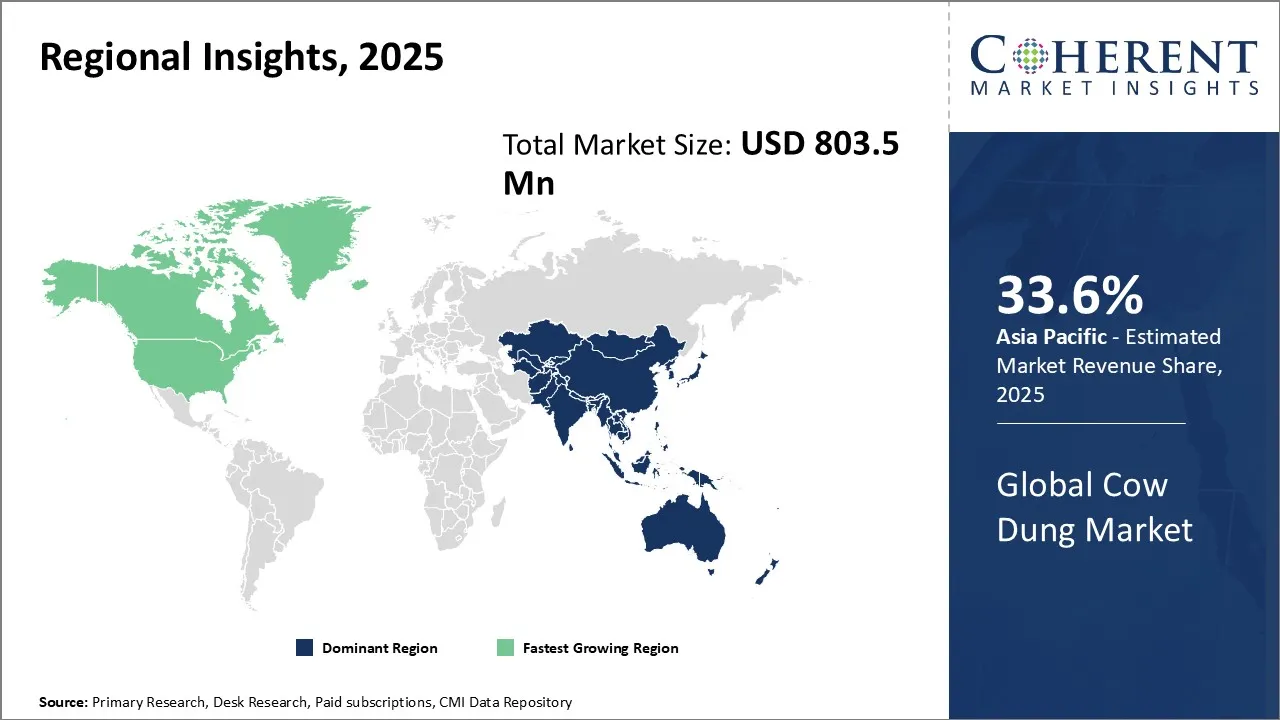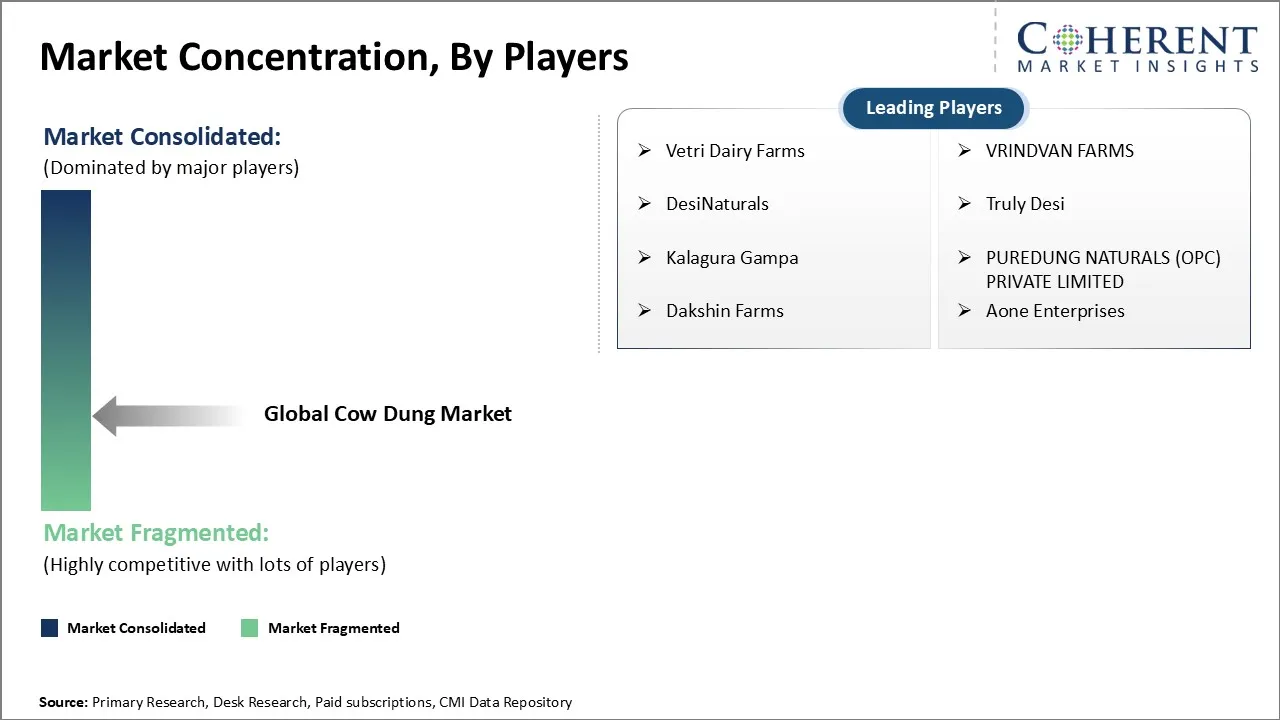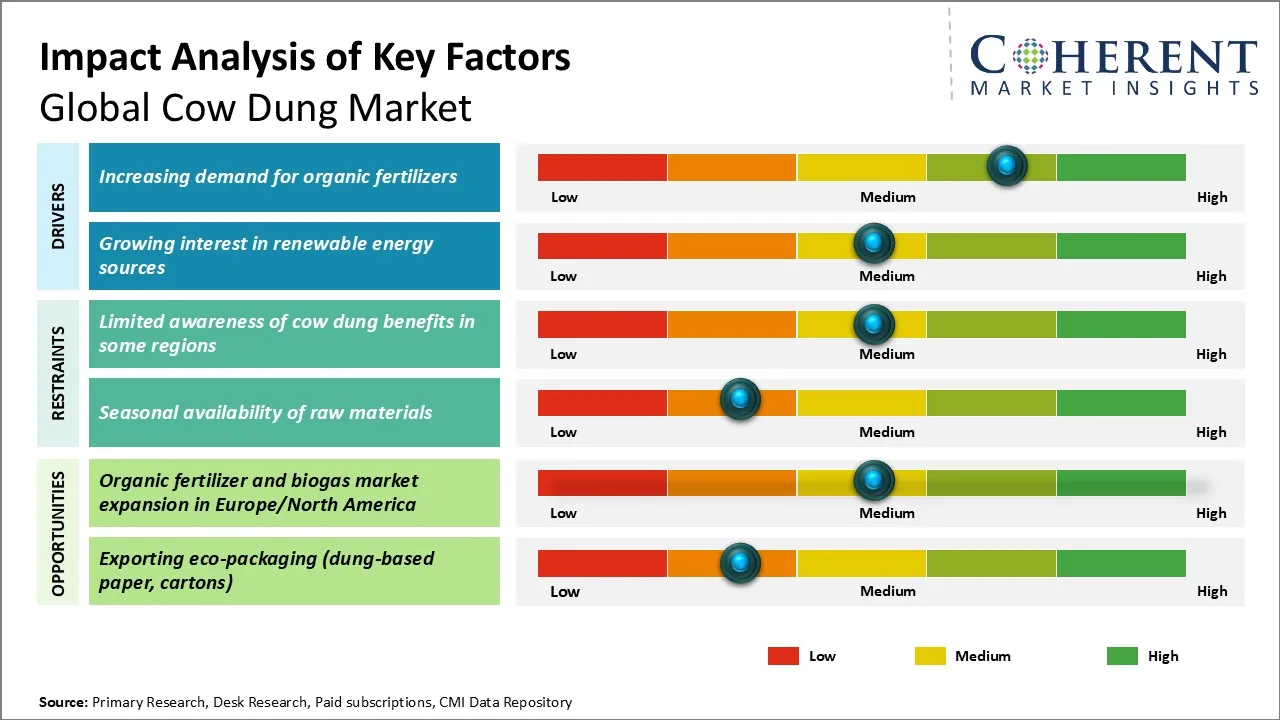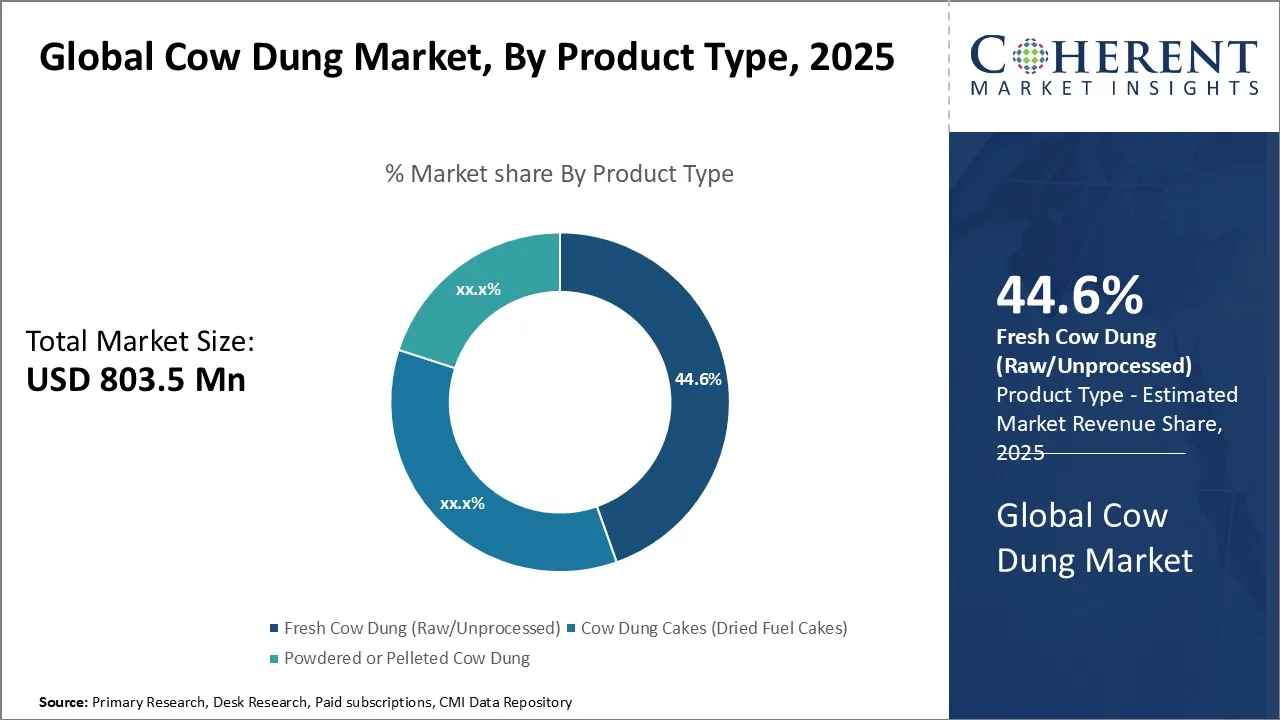Global Cow Dung Market Size and Forecast – 2025-2032
The Global Cow Dung Market is estimated to be valued at USD 803.5 Mn in 2025 and is expected to reach USD 1,248.6 Mn by 2032, exhibiting a compound annual growth rate (CAGR) of 6.5% from 2025 to 2032.
Key Takeaways of the Cow Dung Market
- The fresh cow dung (raw/unprocessed) segment is projected to account for 44.6% of the market share in 2025, driven by the increasing demand for organic fertilizers in agriculture.
- The fuel segment is expected to account for 32.2% of the global cow dung market share in 2025. For centuries, cow dung has served as a traditional fuel, especially in rural communities within developing nations.
- The smallholder & commercial farmers segment is projected to hold a 29.6% share of the global cow dung market in 2025.
- Asia Pacific is set to lead the global cow dung market in 2025 with a 33.6% share, driven by agricultural activities, increasing demand for organic fertilizers, and the growing popularity of biogas production. North America, with a 12.5% share in 2025, will be the fastest-growing region, with a steady adoption of biogas technology and cow dung-based fertilizers in organic farming.
Market Overview
The cow dung market is witnessing a significant upward trend due to the increasing demand for organic fertilizers and the growing awareness about sustainable farming practices. The market is driven by factors such as the rising popularity of organic food, the need to reduce chemical fertilizer usage, and the increasing adoption of cow dung as a green energy source through biogas production. Additionally, government initiatives promoting organic farming and the use of cow dung for various applications are expected to further fuel market growth during the forecast period.
Currents Events and their Impact
|
Current Events |
Description and its impact |
|
Launch of National Biogas Incentive Programs (e.g., India, 2025) |
|
|
Technological Advance: AI-Driven Composting Systems |
|
Uncover macros and micros vetted on 75+ parameters: Get instant access to report
Cow Dung Market Insights, By Product Type - Fresh Cow Dung (Raw/Unprocessed) Segment dominates due to Increasing Demand for Organic Fertilizers
Fresh cow dung (raw/unprocessed) segment is expected to contribute 44.6% share of the market in 2025, owing to the growing demand for organic fertilizers in agriculture. Fresh cow dung is a rich source of nutrients, including nitrogen, phosphorus, and potassium, which are essential for plant growth. It also contains beneficial microorganisms that improve soil health and fertility. As consumers become more health-conscious and environmentally aware, the demand for organic produce has increased significantly. This, in turn, has led to a higher demand for organic fertilizers like fresh cow dung.
Cow Dung Market Insights, By Application- Fuel Segment Drives Market Growth due To Growing Demand of the Traditional Use of Cow Dung
The fuel segment is projected to contribute 32.2% share of the global cow dung market in 2025. Cow dung has been used as a traditional fuel source for centuries, particularly in rural households in developing countries. Dried cow dung cakes are a popular form of fuel for cooking and heating in many parts of Asia Pacific and Africa. They are an affordable and readily available alternative to firewood and other fuel sources, which can be scarce or expensive in many rural areas.
Cow Dung Market Insights, By End User - Smallholder and Commercial Farmers Drive Demand for Cow Dung
Smallholder & commercial farmers segment is projected to contribute 29.6% share of the global cow dung market in 2025. Farmers, particularly in developing countries, are the primary consumers of cow dung, using it as a natural fertilizer and soil conditioner. Cow dung is rich in nutrients and organic matter, which can improve soil structure, fertility, and water retention capacity. This, in turn, can lead to higher crop yields and better-quality produce.
Regional Insights:

To learn more about this report, Download Free Sample
Asia Pacific Cow Dung Market Analysis and Trends
The Asia Pacific region is projected to lead the market with a 33.6% share in 2025. The region's large livestock population, particularly in countries like India and China, ensures a steady supply of cow dung. Additionally, the widespread use of cow dung as a natural fertilizer in agriculture and the growing adoption of biogas technology for energy production contribute to the market's growth. Government initiatives promoting organic farming and sustainable energy solutions further support the market's expansion. Notable companies in the region include Vetri Dairy Farms, which has established a strong distribution network for cow dung-based products, known for its innovative biogas digesters.
North America Cow Dung Market Analysis and Trends
The North America region is expected to exhibit the fastest growth in the market contributing 12.5% share in 2025. The increasing awareness about organic farming practices and the rising demand for natural and sustainable fertilizers are key drivers of market growth in the region. The presence of stringent environmental regulations such as waste management regulations and the growing emphasis on reducing carbon footprint have led to the adoption of cow dung-based products in agriculture and horticulture.
Global Cow Dung Market Outlook for Key Countries:
U.S. Cow Dung Market Trends
The U.S. cow dung market is driven by the increasing demand for organic and sustainable agricultural practices. The country's large dairy industry provides a consistent supply of cow dung, which is used in the production of organic fertilizers and soil amendments. The market is also supported by government initiatives that encourage sustainable farming practices and the adoption of renewable energy sources.
For instance, cow dung from India is gaining significant popularity in the U.S., particularly due to its use in organic farming, eco-friendly products, and traditional practices. Its appeal is driven by the growing interest in sustainable agriculture and natural, biodegradable materials. Cow dung is being marketed for composting, as a natural pesticide, and even for religious or cultural purposes.
India Cow Dung Market Trends
India cow dung market is deeply rooted in the country's cultural and religious beliefs, where cows are considered sacred. The widespread availability of cow dung and its traditional use as a fuel and fertilizer have contributed to the market's growth. The Indian government's push towards organic farming and the promotion of biogas technology have further fueled the demand for cow dung-based products.
A key player contributing significantly to this market is Bharat Biogas, which has been actively involved in promoting biogas production from cow dung. By setting up biogas plants across rural areas, Bharat Biogas not only helps in the efficient utilization of cow dung but also contributes to sustainable energy production.
Brazil Cow Dung Market
Brazil cow dung market for is driven by the country's extensive livestock industry and the growing demand for organic fertilizers in agriculture. The increasing awareness about the benefits of using cow dung as a natural and sustainable alternative to chemical fertilizers has fueled market growth. Brazilian companies, like Raízen Geo Biogas, have established strong relationships with farmers and have invested in the development of specialized cow dung-based products for various agricultural applications.
China Cow Dung Market
China cow dung market is characterized by the country's large agricultural sector and the increasing adoption of sustainable farming practices. The Chinese government's focus on reducing environmental pollution and promoting the use of renewable energy sources has created opportunities for the cow dung market.
India’s Export & Commercial Opportunity:
- Top importers: Maldives, Cambodia, Vietnam, Singapore, the U.A.E, the U.S., and China
- Product mix: India supplies fresh dung, fertilizer, compost, dried cakes, powder and has emerging roles in dung-based biofuels, paints, packaging.
- Opportunities:
- Organic fertilizer and biogas market expansion in Europe/North America
- Exporting eco-packaging (dung-based paper, cartons)
- Positioning spiritual/ritual dung products (e.g., for ceremonial use in the Middle East)
Cow Dung Cake Export (India):
- India produces 3 million tons/day of cow dung
- Strong domestic use for fertilizer, cook-fuel cakes, biogas, and cottage industries.
- In 2024, exports valued at INR 125 crore (~US$ 16 Mn) for raw dung;
- INR 173.7 crore (US$ 22 Mn) for fertilizers
- INR 88 crore (~US$ 11 Mn) for compost (2023–24)
- India’s raw dung selling price: INR 30–INR 50 (~US$ 0.35–0.60/kg) . Gulf countries sometimes pay up to INR 50 (US$ 0.60)/kg.
Market Players, Key Development, and Competitive Intelligence:

To learn more about this report, Download Free Sample
Key Developments:
- Kalagura Gampa is an Indian company that offers a variety of eco-friendly and traditional cow dung-based products, primarily aimed at the agricultural and spiritual markets. Its offerings include sun-dried cow dung cakes, which are hand-shaped and chemical-free. These cakes are widely used in religious rituals, such as pujas and havans, and also serve as natural mosquito repellents when burned. Additionally, they offer cow dung lamps made with ghee or Panchagavya, which provide a clean and aromatic burn during spiritual practices and festivals.
- Truly Desi is a prominent player in the cow dung market, known for offering a range of organic and eco-friendly products derived from cow dung. Its product line primarily includes organic fertilizers, which are gaining popularity due to their natural and sustainable properties. These fertilizers are rich in nutrients that improve soil health, enhance crop yield, and reduce the dependency on chemical fertilizers.
Top Strategies Followed by Global Cow Dung Market Players
- Established players in the global cow dung market are focusing on extensive research and development to innovate high-performance products. These companies are investing heavily in R&D to develop new and improved cow dung-based products such as organic fertilizers, biogas, and eco-friendly packaging materials.
- For instance, India-based Agro Bio Tech, a major player in the sector, has developed a line of organic fertilizers from cow dung that improves soil health while maintaining sustainability. By advancing these innovations, they aim to stay ahead of competition and reinforce their market dominance.
- Mid-level players in the global cow dung market are focusing on delivering cost-effective solutions to target price-sensitive consumers. They are developing quality products that are budget-friendly, without compromising on performance. This strategy allows them to capture a significant share of the market, particularly in developing countries where price is a crucial factor in purchasing decisions.
- For example, Cow Dung Industries Ltd. has partnered with Linde Group to integrate their cow dung-derived biogas into the energy sector. Such alliances provide access to new markets and enhanced distribution networks.
- Small-scale players in the global cow dung market are adopting niche specialization strategies to differentiate themselves from their larger counterparts. They are targeting specific niche markets with unique features or innovative products that cater to the specific needs and preferences of their customers. This approach allows them to carve out a distinct identity in the market and attract a loyal customer base.
- For example, Kalpavriksha Organics, a small-scale company in India, focuses on producing artisanal cow dung products for spiritual purposes, such as organic cow dung incense and ceremonial cakes. This strategy helps them carve out a distinct identity and attract a loyal customer base.
Market Report Scope
Cow Dung Market Report Coverage
| Report Coverage | Details | ||
|---|---|---|---|
| Base Year: | 2024 | Market Size in 2025: | USD 803.5 Mn |
| Historical Data for: | 2020 To 2024 | Forecast Period: | 2025 To 2032 |
| Forecast Period 2025 to 2032 CAGR: | 6.5% | 2032 Value Projection: | USD 1,248.6 Mn |
| Geographies covered: |
|
||
| Segments covered: |
|
||
| Companies covered: |
Vetri Dairy Farms, VRINDVAN FARMS, DesiNaturals, Truly Desi, Kalagura Gampa, PUREDUNG NATURALS (OPC) PRIVATE LIMITED, Dakshin Farms, and Aone Enterprises |
||
| Growth Drivers: |
|
||
| Restraints & Challenges: |
|
||
Uncover macros and micros vetted on 75+ parameters: Get instant access to report
Cow Dung Market Dynamics

To learn more about this report, Download Free Sample
Cow Dung Market Driver - Increasing Demand for Organic Fertilizers
The global cow dung market is experiencing significant growth due to the increasing demand for organic fertilizer in agriculture. As consumers become more health-conscious and environmentally aware, the preference for organic produce has risen substantially. This shift in consumer behavior has led farmers to adopt sustainable and eco-friendly farming practices, including the use of cow dung as a natural fertilizer. Cow dung is rich in nutrients such as nitrogen, phosphorus, and potassium, which are essential for plant growth and soil health.
This shift in consumer behavior has led to a surge in organic farming practices, which rely heavily on natural fertilizers like cow dung. Cow dung is rich in nutrients such as nitrogen, phosphorus, and potassium, making it an excellent organic fertilizer for crops. According to the Food and Agriculture Organization of the United Nations (FAO), the global organic food market reached a value of USD 120 billion in 2020, with a projected growth rate of 10-12% annually until 2025. This expanding organic food market directly impacts the demand for cow dung as a natural fertilizer, thereby driving the growth of the cow dung market.
Cow Dung Market Opportunity - Organic Fertilizer and Biogas Market Expansion in Europe/North America
The expanding organic fertilizer and biogas markets in Europe and North America present a significant opportunity for the global cow dung market. As consumers in these regions become increasingly conscious of the environmental impact of their choices, there is a growing demand for sustainable and eco-friendly products. Cow dung-based organic fertilizers offer a viable alternative to synthetic fertilizers, as they are natural, biodegradable, and rich in nutrients essential for plant growth.
Furthermore, the use of cow dung in biogas production can help reduce greenhouse gas emissions and provide a renewable energy source. With stringent regulations and government support for sustainable practices in Europe and North America, the market for cow dung-based products is expected to witness substantial growth in these regions. Market players can capitalize on this opportunity by focusing on product innovation, collaborating with local partners, and ensuring compliance with regional standards and certifications.
Analyst Opinion (Expert Opinion):
- The global cow dung market is experiencing a renaissance, driven by its multifaceted applications in agriculture, energy production, and sustainable building materials. Companies like Gobar Times are pioneering the conversion of cow dung into biofertilizers and biogas, capitalizing on the growing demand for organic farming solutions. Recent conferences, such as the International Conference on Organic Waste Management (2022) and the Bioenergy Conference (2023), have showcased innovative uses of cow dung, emphasizing its potential to contribute to circular economy practices.
- These events highlight the need for collaboration among stakeholders to overcome challenges related to processing and acceptance in mainstream markets. As sustainability becomes a priority for industries worldwide, the cow dung market is set for substantial growth, driven by technological advancements and an increasing recognition of its environmental benefits.
Market Segmentation
- Product Type Insights (Revenue, USD Mn, 2020 - 2032)
-
- Fresh Cow Dung (Raw/Unprocessed)
- Cow Dung Cakes (Dried Fuel Cakes)
- Powdered or Pelleted Cow Dung
- Application Insights (Revenue, USD Mn, 2020 - 2032)
-
- Fuel
- Renewable Energy (Biogas, Bio-CNG)
- Fertilizers & Soil Conditioning
- Industrial & Cottage Products
- Others
- End User Insights (Revenue, USD Mn, 2020 - 2032)
-
- Smallholder & Commercial Farmers
- Rural/Urban Households
- Industrial & Cottage Producers
- Urban Organic Consumers
- Biogas/Bio-CNG Plants
- Distribution Channel Insights (Revenue, USD Mn, 2020 - 2032)
-
- Farmgate & Village Cooperatives
- Agricultural Suppliers & Organic Stores
- Energy Infrastructure
- Industrial Input Supply
- Regional Insights (Revenue, USD Mn, 2020 - 2032)
-
- North America
- U.S.
- Canada
- Latin America
- Brazil
- Argentina
- Mexico
- Rest of Latin America
- Europe
- Germany
- U.K.
- Spain
- France
- Italy
- Russia
- Rest of Europe
- Asia Pacific
- China
- India
- Japan
- Australia
- South Korea
- ASEAN
- Rest of Asia Pacific
- Middle East
- GCC Countries
- Israel
- Rest of Middle East
- Africa
- South Africa
- North Africa
- Central Africa
- North America
- Key Players Insights
- Vetri Dairy Farms
- VRINDVAN FARMS
- DesiNaturals
- Truly Desi
- Kalagura Gampa
- PUREDUNG NATURALS (OPC) PRIVATE LIMITED
- Dakshin Farms
- Aone Enterprises
Sources:
Primary Research Interviews:
- Agricultural Scientist – Organic Fertilizer Research Center
- Procurement Head – Major Bio-Manure Manufacturer
- Sustainability Officer – Eco-Agriculture NGO
- Operations Manager – Rural Biogas Plant Operator
Stakeholders:
- Producers:
- Organic fertilizer manufacturers
- Biogas plant operators
- Dried dung cake producers
- End-use Sectors:
- Agriculture & Organic Farming
- Energy/Biogas Plants
- Construction (mud bricks, flooring)
- Religious & Cultural Use (India, Nepal, etc.)
- Regulatory & Development Bodies:
- Agricultural Ministries (e.g., India’s Ministry of Agriculture)
- Renewable Energy Agencies
- E-commerce & Distribution:
- Agri-tech platforms
- Rural cooperatives and mandi networks
Databases:
- UN Food and Agriculture Organization (FAO) – Livestock population and manure statistics
- India EXIM Database – Dung-based export/import trends
- National Sample Survey Office (NSSO), India – Rural fuel and organic input usage
- International Renewable Energy Agency (IRENA) – Biogas from cow dung data
- MNRE India – Biogas scheme utilization
Magazines:
- Down To Earth – Centre for Science and Environment – Organic farming and rural innovation
- AgriBusiness Global – Natural inputs and sustainable fertilizer trends
- BioEnergy Insight – Biogas generation and feedstock analysis
- Rural Today (India) – Traditional applications of cow dung in homes and agriculture
- The Organic Farmer – Composting and circular economy
Journals:
- Renewable Energy Journal – Cow dung-based biogas studies
- Waste Management Journal – Manure handling and valorization
- Agricultural Systems – Cow manure use in traditional and modern farming
- Journal of Environmental Management – Emissions from dung burning vs. biogas
Newspapers
- The Hindu Business Line – Cow dung as a fuel and fertilizer commodity in India
- Times of India – Cow dung exports and innovation in usage
- Economic Times – Dung-based startups and sustainable packaging
- The Guardian (UK) – Biogas initiatives using cow waste
- BBC News Asia – Traditional vs. modern use of cow dung in India
Associations:
- International Biogas Association
- Indian Biogas Association
- Organic Farming Association of India (OFAI)
- Global Alliance for Clean Cookstoves
- Federation of Indian Animal Protection Organizations (FIAPO) – Dung sustainability practices
Public Domain Sources
- Ministry of New and Renewable Energy (India) – Gobar-Dhan Scheme and biogas data
- NITI Aayog – Reports on cow dung utilization for rural energy
- National Institute of Animal Nutrition and Physiology (NIANP) – Manure analysis
- European Biogas Association – Cow manure contribution in EU biogas
Proprietary Elements:
- CMI Data Analytics Tool, Proprietary CMI Existing Repository of information for last 8 years.
Share
Share
About Author
Sakshi Suryawanshi is a Research Consultant with 6 years of extensive experience in market research and consulting. She is proficient in market estimation, competitive analysis, and patent analysis. Sakshi excels in identifying market trends and evaluating competitive landscapes to provide actionable insights that drive strategic decision-making. Her expertise helps businesses navigate complex market dynamics and achieve their objectives effectively.
Missing comfort of reading report in your local language? Find your preferred language :
Transform your Strategy with Exclusive Trending Reports :
Frequently Asked Questions
EXISTING CLIENTELE
Joining thousands of companies around the world committed to making the Excellent Business Solutions.
View All Our Clients


